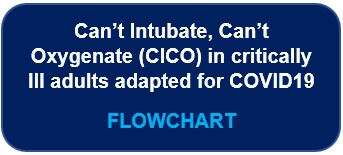Breadcrumbs
Anesthesia in Patients with Positive COVID Status & Difficult Airway
- In addition to applying all COVID positive status infection policy and anesthesia management plan, an additional experienced anesthesia assistant is required for airway management.
- Prepare plans A, B and C and discuss among airway team members. The choice of airway management is likely dependent on the skill sets of the team members and the baseline cardio-respiratory status of the patient (e.g., the degree of hypoxemia).
- For COVID positive patients with difficult airway, suggest take control of the airway electively and in a controlled fashion. Additionally take into consideration aerosol minimization strategies (e.g., avoid coughing and manual ventilation) and anticipate the likelihood of rapid oxygen desaturation during intubation.
- Recommend 2 anesthesiologists to attend the case.
- First decide whether to intubate the patient asleep or awake, noting that awake intubation is strongly discouraged (high risk of viral aerosolization).
Asleep Intubation (a flow diagram)
- If asleep intubation is deemed most appropriate, administer induction agent and muscle relaxation (e.g., rocuronium 1.5 mg/kg).
- Perform video laryngoscopy with a styleted ETT as the first choice since this is a familiar technique to most anesthesiologists. Also consider using tracheal tube introducer (bougie)
- However, if video laryngoscopy is considered inappropriate, contraindicated or unsuccessful, suggest fiberoptic intubation alone or combined with video laryngoscopy.
- Limit the number of fibertopic intubation attempts while monitoring for signs of severe oxygen desaturation.
- If absolutely necessary to assist ventilation as rescue, apply 2 hand vice grip gentle face mask ventilation with minimal tidal volume and peak pressure to maintain oxygenation.
- Quickly switch to a supraglottic airway device e.g., Intubating LMA or air-Q to further decrease air leak and as a conduit to facilitate intubation.
- In the OR setting, if all airway attempts fail, consider reversing muscle relaxation with sugammadex and wake up the patient.
Awake Intubation
- Avoid awake intubation at all cost. However, if an awake intubation is considered the best and only option, consider an oral or nasal fiberoptic intubation.
- Recommend to suppress cough by applying topical local anesthesia to the airway e.g., lidocaine viscus / paste / gel and lidocaine soaked pledgets without aerosolization (i.e., avoid atomizer and nebulizer). Perform the topical anesthesia procedure slowly and step by step to avoid precipitating sneeze and cough.
- Consider using small incremental doses of sedatives e.g., ketamine and dexmedetomidine or short acting opioid e.g., remifentanil to assist with local topicalization and intubation if necessary.
- If performing a nasal fiberoptic intubation, consider covering patient’s mouth with a surgical mask and an oxygen face mask below the nose to minimize viral aerosolization.
- Also consider further contain the degree of viral aerosolization by creating a tent made of plastic drape to surround the patient’s head.
- Recommend to minimize viral aerosolization by covering patient’s mouth with a surgical mask and an oxygen face mask below the nose.
Can’t Intubate Can’t Oxygenate
- Proceed to an emergency front of neck airway (eFONA) if can’t intubate and can’t oxygenate. The scalpel-bougie-tube technique is particularly preferred in COVID-19 patients over the cannula techniques because it does not require oxygen insufflation thus minimize the risk of aerosolisation.
